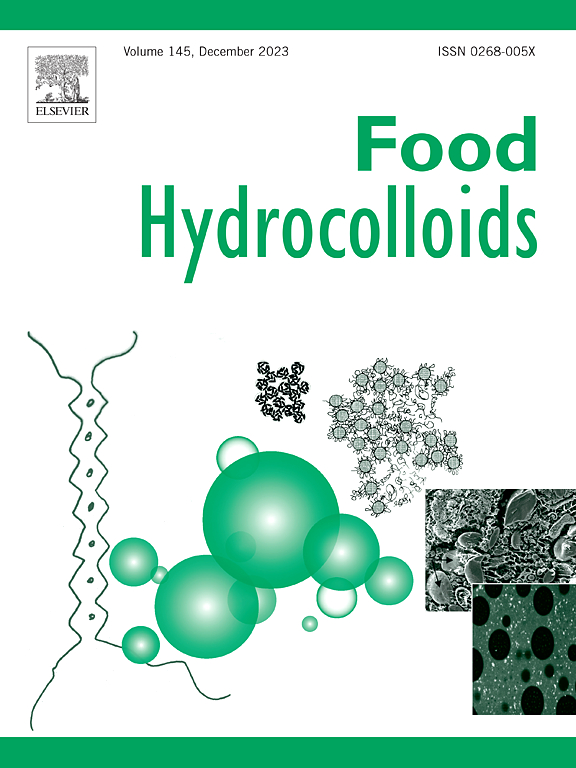Lactoferrin-low methoxyl pectin (LMP) composite hydrogels: Mechanical and structural properties tailored by LMP and calcium
IF 11
1区 农林科学
Q1 CHEMISTRY, APPLIED
引用次数: 0
Abstract
Lactoferrin (LF)-low methoxyl pectin (LMP, 0–0.2 %, w/v) composite hydrogels with great mechanical properties were fabricated with calcium ions (Ca2+, 50 and 100 mM). Incorporation of LMP induced changes in mechanical properties by increasing steric hindrance and altering the structure of LF. These changes contributed to denser microstructure of hydrogels with 50 and 100 mM Ca2+, leading to superior texture profiles (hardness increased by 22 %–152 % and 50 %–251 %), viscoelastic properties (G′ increased by 25 %–286 % and 6 %–175 %), and water holding capacity (increased by 15 %–26 % and 19 %–30 %), with 0.1 % LMP being the optimal. Hydrogels with 100 mM Ca2+ exhibited less homogeneous and compact networks compared to those with 50 mM Ca2+, resulting in suboptimal gel properties. Independent of LMP and Ca2+ level, all hydrogels contained bound water (∼5 %) and immobilized water (∼95 %), and manifested amorphous structures. Fluorescence spectra elucidated the tertiary structure changes caused by LMP and Ca2+. Non-covalent interactions, especially hydrophobic interaction, maintained the LF-LMP hydrogels. Intermolecular force analysis implied the strength of interactions was related to LMP and Ca2+ concentrations. Pearson's correlation analysis confirmed that a dense and uniform gel network favors the hydrogel's mechanical properties and water holding capacity. Data suggest that LMP and Ca2+ altered the microstructure of LF hydrogel by modifying the conformation and intermolecular forces, thus regulating the mechanical properties.

乳铁蛋白-低甲氧基果胶(LMP)复合水凝胶:由LMP和钙定制的机械和结构性能
采用钙离子(50和100 mM)制备了具有良好力学性能的乳铁蛋白(LF)-低甲氧基果胶(LMP, 0 - 0.2%, w/v)复合水凝胶。LMP的加入通过增加位阻和改变LF的结构而引起力学性能的变化。这些变化导致50和100 mM Ca2+水凝胶的微观结构更致密,从而导致优越的织构轮廓(硬度增加22% - 152%和50% - 251%),粘弹性性能(G′增加25% - 286%和6% - 175%)和持水量(增加15% - 26%和19% - 30%),其中0.1%的LMP是最佳的。与具有50 mM Ca2+的水凝胶相比,具有100 mM Ca2+的水凝胶表现出较不均匀和紧凑的网络,导致凝胶性能不理想。与LMP和Ca2+水平无关,所有水凝胶均含有结合水(~ 5%)和固定化水(~ 95%),并表现为无定形结构。荧光光谱分析了LMP和Ca2+引起的三级结构变化。非共价相互作用,特别是疏水相互作用维持了LF-LMP水凝胶。分子间力分析表明,相互作用的强度与LMP和Ca2+浓度有关。Pearson的相关分析证实,致密和均匀的凝胶网络有利于水凝胶的力学性能和持水能力。数据表明,LMP和Ca2+通过改变LF水凝胶的构象和分子间力来改变其微观结构,从而调节其力学性能。
本文章由计算机程序翻译,如有差异,请以英文原文为准。
求助全文
约1分钟内获得全文
求助全文
来源期刊

Food Hydrocolloids
工程技术-食品科技
CiteScore
19.90
自引率
14.00%
发文量
871
审稿时长
37 days
期刊介绍:
Food Hydrocolloids publishes original and innovative research focused on the characterization, functional properties, and applications of hydrocolloid materials used in food products. These hydrocolloids, defined as polysaccharides and proteins of commercial importance, are added to control aspects such as texture, stability, rheology, and sensory properties. The research's primary emphasis should be on the hydrocolloids themselves, with thorough descriptions of their source, nature, and physicochemical characteristics. Manuscripts are expected to clearly outline specific aims and objectives, include a fundamental discussion of research findings at the molecular level, and address the significance of the results. Studies on hydrocolloids in complex formulations should concentrate on their overall properties and mechanisms of action, while simple formulation development studies may not be considered for publication.
The main areas of interest are:
-Chemical and physicochemical characterisation
Thermal properties including glass transitions and conformational changes-
Rheological properties including viscosity, viscoelastic properties and gelation behaviour-
The influence on organoleptic properties-
Interfacial properties including stabilisation of dispersions, emulsions and foams-
Film forming properties with application to edible films and active packaging-
Encapsulation and controlled release of active compounds-
The influence on health including their role as dietary fibre-
Manipulation of hydrocolloid structure and functionality through chemical, biochemical and physical processes-
New hydrocolloids and hydrocolloid sources of commercial potential.
The Journal also publishes Review articles that provide an overview of the latest developments in topics of specific interest to researchers in this field of activity.
 求助内容:
求助内容: 应助结果提醒方式:
应助结果提醒方式:


